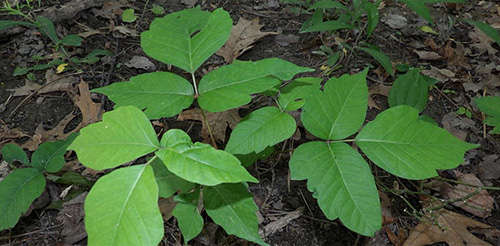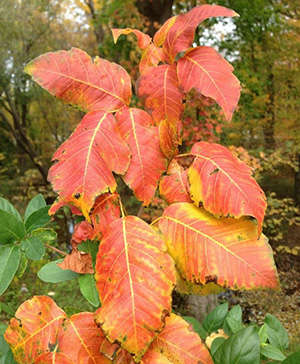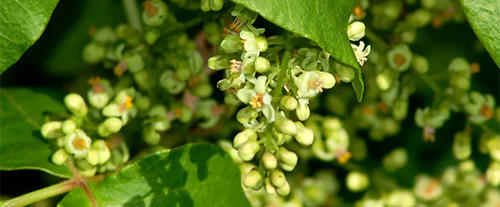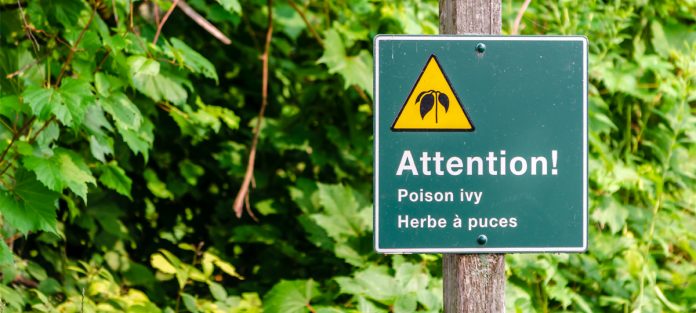Poison ivy (Toxicodendron radicans) is a very common U.S. herb, and is very persistent. Poison ivy is growing widespread, and can take over an environment quickly.
An itchy rash on the skin where the contact happened is one common indication that you have had touch with poison ivy. It may only be red and itchy, but the rash usually forms blisters filled with fluid before long. When you scratch, this rash will spread easily to other body parts, or to family and friends. And trust me, that’s not a good thing. Not everyone responds to poison ivy, and if you don’t get a rash, you might be immune. Carefully investigate the suspicious plant, because members of your family can respond badly. I’ll show you in this article how to find poison ivy in your backyard or neighborhood and how to get rid of it.
Growth Habit Of Poison Ivy
The plant is most well known for the three-leaf pattern in each collection. But where it grows in a mass, there are several leaves bunching together and you might not know that the leaves are in three sets, so look closely and don’t touch.

Poison ivy is not a real ivy but it has a similar pattern of growth. Surfaces such as walls, fences, trees or bushes, between rocks, and along the ground grow. It can, however, also grow in a bush pattern, or form a dense growth mass. I’ve also seen the vines curl around and take the shape of a tree.
Related: All-Natural, Home Remedies for High Blood Pressure
The Leaves Of Poison Ivy

As already mentioned, poison Ivy leaves often grow in sets of three. But, some other plants also grow in 3 clusters. When you see three leaves in set, be careful. Check for the other identifying features without having to touch the plant.
During summer, poison ivy plants are usually bright green and in autumn turn yellow to red. You will often see young, smaller red leaves alongside the green leaves. In autumn, leaves can be dark red or orange or yellow everywhere, and can even be mottled in both colours. Sporty yellow or orange leaves can also be poison oak.
In my area, poison ivy leaves are typically smooth and lance-shaped, but some varieties are serrated or even lobed. All varieties hit a point at the tip of the vine.
Growing three-leaf group has a center-leaf that is longer than the two side leaves and has a stem. Through the vine the side-leaves grow directly. Unfortunately, if you are not looking closely you may not notice the difference. The difference is small, but it is there.
The leaves sometimes look darker and waxy or shinier, but this isn’t always true. The undersides are lighter and fluffier in color. Should not be tempted to touch it either. If need be, wear gloves.
The Vine And Poison Ivy Flowers
Typically in the spring, the vine or bush will grow clusters of small flowers. The flowers are mostly white, but they may also be yellowish white, with yellow centres.

As the flowers fade, small white clusters, greenish-white or tan berries emerge and remain in the vine all season. Birds are consuming these berries, but you should never be tempted – notice the word “poison” in their name?
Teach Grandchildren To Avoid Poison Ivy
Teachers and parents have come up with rhymes to encourage children to identify poison ivy and stop it. The one I heard as a child was “Leaves of three; let them be!” which also worked for poison oak. Here are some others:
- Count the leaves, 1, 2, 3? Don’t touch me!
- Berries white, danger in sight.
- Berries white, run in fright.
- Longer middle stem? Stay away from them.
- Red leaves in the spring is a dangerous thing.
- Side leaves like mittens, itches like the dickens.
How To Get Rid Of Poison Ivy In Your Backyard
Stop! Learn all these guidelines before even considering getting rid of poison ivy. My father-in-law was one of those fortunate people immune from poison ivy. However, as he started removing it from his garden, he wanted to burn the vines to make sure that the plants were gone completely. That’s a very bad choice even if you’re immune. He found that he was not immune to smoke, and had one of the worst poison ivy cases ever. The smoke will hurt your lungs as well – imagine that rash! So, no burning! Similarly, no compost. You don’t need your compost to grow a new crop of poison ivy or to spread across your garden.
Related: How To Prepare Medicinal Pickled Garlic
Dress For The Job
Protective clothing is required no matter what method you select. Wear shoes, socks, long pants, shirt with long sleeves, and gloves. Choose clothing that is not absorbent, such as a windbreaker, hip waders, or other waterproof clothing, if possible. The plant oils will soak into normal clothing when you deal with lots of plants. And be very careful, not to touch your skin when taking off your clothes.
Apply Herbicides On Poison Ivy
Perhaps this is the best way to get rid of poison ivy, but my least favorite. I really don’t like spraying surfaces where my kids play. Glyphosate-containing herbicides, triclopyr, amitrole, or 2, 4-D will do the job. Only ensure that plants are removed and the poison ivy plants continue to be sprayed until they are dead, several sprays will be taken. When you have destroyed them, dig up the plants, roots and everything, and place them in a plastic lawn bag. Test the area closely during the next spring to make sure there are no new sprouts.
My Favorite Method
I recommend this method because it is only a little more work than the herbicide method and it works without adding dangerous chemicals to the environment.
This Is A Four-Step Method:
1. Wearing protective clothing, remove the vines at ground level with gardening shears. After use, clean the shears with soapy water to remove all oils. For disposal put the vines in a plastic lawn bag.
2. Choose a day when the soil is warm or muddy. It makes digging easier without crushing them and having the smaller side roots. Wearing gloves, digging up the whole root system, using the shovel tip to extract small bits that may get loose. Place the roots away in a plastic lawn bag.
3. This move is optional or you could skip step 2 and do just that. Yet I want to do both moves to ensure I get as many of the roots as I can. For this step, pour boiling water into the hole and stretch out around the roots that have been removed. That will destroy any remaining roots in the soil. Repeat this move in a row for several days and watch for returning sprouts.
4. Early the following spring, start looking for sprouts that may have survived and treat them as well. Poison ivy is hard to completely kill, it just seems to always come back. So, you have to be on watch.
I can’t over-emphasize the importance of being careful about poison ivy on your property. If overlooked, it can cause much suffering. If you remove it as soon as possible, and watch the area as a hawk for returning sprouts, the best results are achieved.
I hope that helps you find any poison ivy in your yard and kill it. This is one plant you shouldn’t forget.











